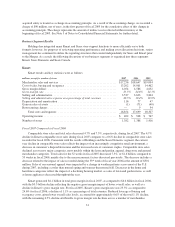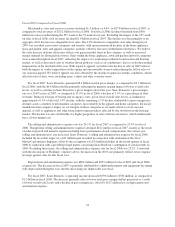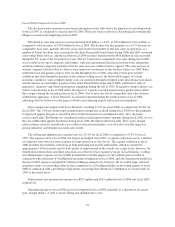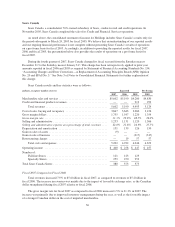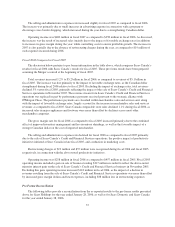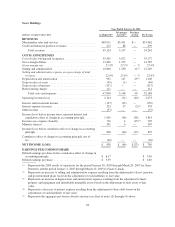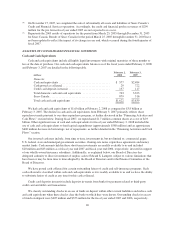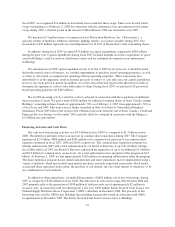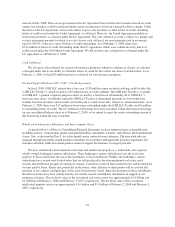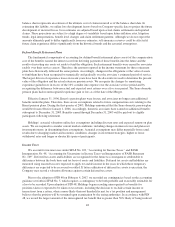Sears 2007 Annual Report Download - page 41
Download and view the complete annual report
Please find page 41 of the 2007 Sears annual report below. You can navigate through the pages in the report by either clicking on the pages listed below, or by using the keyword search tool below to find specific information within the annual report.Investment of Available Capital
Since the Merger, our cash flows have exceeded our working capital, financing and capital investment
needs, and management expects that our cash flows will continue to exceed our annual operating cash needs for
the foreseeable future. We have and will continue to invest in our businesses to improve the customer experience
and provide the opportunity for attractive returns. Further, through February 2, 2008, we have repurchased $4.3
billion of our common shares since the Merger and may continue to repurchase shares subject to market
conditions and board authorization. In addition, we may pursue investments in the form of acquisitions, joint
ventures and partnerships where we believe attractive returns can be obtained. Further, we may determine under
certain market conditions that available capital is best utilized to fund investments that we believe offer us
attractive return opportunities, whether or not related to our ongoing business activities.
As previously disclosed, our Board of Directors has delegated authority to direct investment of our surplus
cash to our Chairman, Edward S. Lampert, subject to various limitations that have been or may be from time to
time adopted by the Board of Directors and/or Finance Committee of the Board of Directors. We, from time to
time, invest our surplus cash in various securities and financial instruments, including total return swaps, which
are derivative instruments that synthetically replicate the economic return characteristics of one or more
underlying marketable equity securities. At February 3, 2007, the collateral balance held by our counterparties
based on our total return swaps’ aggregate notional amount of $375 million was $80 million and was recorded as
a current receivable on our consolidated balance sheet. As of February 2, 2008, no collateral was posted in
connection with total return swaps as there were no such investments outstanding.
Operating Activities and Cash Flows
As a retailer, Holdings’ primary source of operating cash flows is the sales of goods and services to
customers, while the primary use of cash in operations is to fund the purchase of merchandise inventories.
Holdings generated approximately $1.5 billion in operating cash flows during fiscal 2007, as compared to
$1.4 billion in fiscal 2006. The increase in net operating cash flows generated during fiscal 2007 as compared to
fiscal 2006 primarily reflects a cash inflow of $66 million related to merchandise inventories in 2007 versus cash
used of $835 million in 2006, offset by an increase in cash used for income and other taxes, as well as decreased
net income.
During fiscal 2005, Holdings generated approximately $2.2 billion in operating cash flows. The lower level
of net operating cash flows generated during fiscal 2006 as compared to fiscal 2005 primarily reflected the
impact of increased merchandise inventories, as well as reduced operating liabilities, partially offset by increased
net income in 2006.
Merchandise inventories at February 2, 2008 were $10.0 billion, as compared to $9.9 billion as of
February 3, 2007. Domestic inventory levels declined from $9.2 billion at February 3, 2007 to $9.1 billion at
February 2, 2008 despite the addition of approximately $160 million of previously consigned pharmacy
inventory. The reduction in domestic inventory levels was offset by an increase in inventory levels at Sears
Canada, largely due to the impact of foreign currency exchange rates. We continue to review and assess our
merchandise inventory levels in an ongoing effort to continuously improve overall returns. Merchandise payables
were $3.5 billion at February 2, 2008, as compared to $3.3 billion as of February 3, 2007.
Investing Activities and Cash Flows
Net cash flows used by investing activities totaled $437 million in fiscal 2007, as compared to $660 million
used in fiscal 2006 and $632 million provided in fiscal 2005. Investing cash flows in all three years were heavily
impacted by a number of significant transactions.
As discussed in the “Results of Operations” and “Investment of Available Capital” sections above, we
entered into total return swaps starting in fiscal 2006 and recognized $74 million of investment income. During
41


